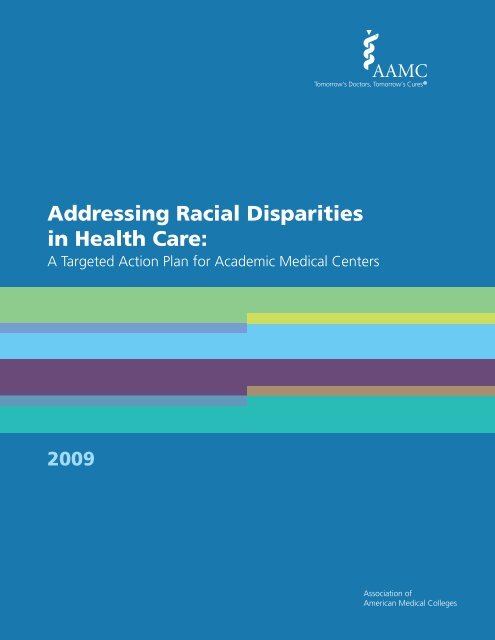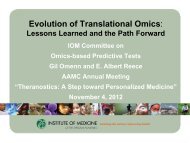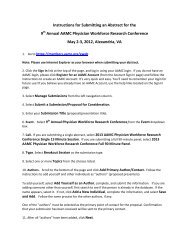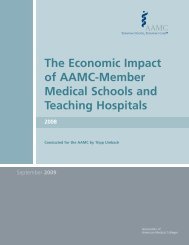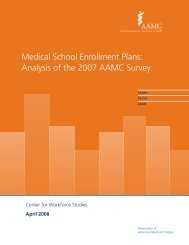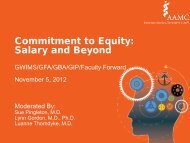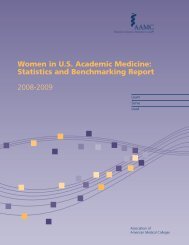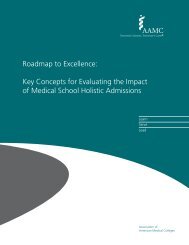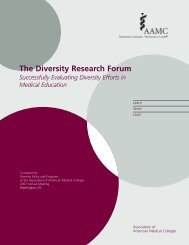Addressing Racial Disparities in Health Care - AAMC's member profile
Addressing Racial Disparities in Health Care - AAMC's member profile
Addressing Racial Disparities in Health Care - AAMC's member profile
- No tags were found...
You also want an ePaper? Increase the reach of your titles
YUMPU automatically turns print PDFs into web optimized ePapers that Google loves.
<strong>Address<strong>in</strong>g</strong> <strong>Racial</strong> <strong>Disparities</strong><strong>in</strong> <strong>Health</strong> <strong>Care</strong>:A Targeted Action Plan for Academic Medical Centers2009Association ofAmerican Medical Colleges
AcknowledgementsThank you to all who participated <strong>in</strong> produc<strong>in</strong>g this publication. In particular, Diversity Policy and Programswith<strong>in</strong> the AAMC would like to thank the author and the reviewers, <strong>in</strong>clud<strong>in</strong>g <strong>member</strong>s of the Diversity and<strong>Disparities</strong> Advisory Group, the Group on Diversity and Inclusion Steer<strong>in</strong>g Committee, and colleagues with<strong>in</strong>the AAMC.This report could not have been accomplished without additional support from the staff <strong>in</strong> the AAMC’sDiversity Policy and Programs:Juan Amador, Director, Group on Diversity and InclusionRuth Beer Bletz<strong>in</strong>ger, Director, Special ProgramsLaura Castillo-Page, PhD, Director of ResearchHugo Dubon, Adm<strong>in</strong>istrative AssociateLily May Johnson, ManagerNorma Poll, PhD, Director, SMDEPKehua Zhang, PhD, Senior Research AnalystIf you have any questions regard<strong>in</strong>g the content of this document, please contact:Diversity Policy and ProgramsAssociation of American Medical Colleges2450 N Street, NWWash<strong>in</strong>gton, DC 20037-1127Phone: 202 828 0570Fax: 202 862 6282To order or download free copies of this publication, please contact:Association of American Medical Colleges Membership Services2450 N Street, NWWash<strong>in</strong>gton, DC 20037-1127Phone: 202 828 0416Fax: 202 828 1123www.aamc.org/publications©2009 Association of American Medical Colleges.
<strong>Address<strong>in</strong>g</strong> <strong>Racial</strong> <strong>Disparities</strong> <strong>in</strong> <strong>Health</strong> <strong>Care</strong>ForewordDespite the excellence of medical education at ournation’s medical schools, health and health care disparitiespersist among populations <strong>in</strong> the United States, <strong>in</strong>clud<strong>in</strong>gracial and ethnic m<strong>in</strong>orities; people liv<strong>in</strong>g <strong>in</strong> ruralcommunities; the poor; and lesbians, gays, transgenderpeople, among others. These disparities are welldocumented <strong>in</strong> the literature (Unequal Treatment, 2003),and their causes are myriad. In 2007, the AAMC(Association of American Medical Colleges) launched astrategic th<strong>in</strong>k<strong>in</strong>g and position<strong>in</strong>g <strong>in</strong>itiative that <strong>in</strong>cludedamong its goals and objectives that staff consider howthe Association could assume a leadership role <strong>in</strong>address<strong>in</strong>g health care disparities. This report, <strong>Address<strong>in</strong>g</strong><strong>Racial</strong> <strong>Disparities</strong> <strong>in</strong> <strong>Health</strong> <strong>Care</strong>: A Targeted Action Planfor Academic Medical Centers, is an important advance<strong>in</strong> our work on that objective.S<strong>in</strong>ce the late 1960’s the AAMC has committed leadershipand resources to support<strong>in</strong>g diversity at our nation’smedical schools and teach<strong>in</strong>g hospitals. Our commitmentto equal access to the profession for qualified and talentedstudents from all backgrounds is grounded <strong>in</strong> fivepr<strong>in</strong>ciples• Achiev<strong>in</strong>g justice and equity,We are deeply grateful for the work of Thomas Sequist,MD, MPH on this report. We believe his research, andthat of future authors <strong>in</strong> this series, will <strong>in</strong>form theacademic medic<strong>in</strong>e community about the potential formedical schools, teach<strong>in</strong>g hospitals, and academicmedical centers to address health care disparities <strong>in</strong>mean<strong>in</strong>gful ways. The recommendations with<strong>in</strong> thisreport should prompt faculty and leaders to considersimple <strong>in</strong>novations that can improve the health of those<strong>in</strong> their communities and the nation.For more <strong>in</strong>formation on this publication and theAAMC’s leadership <strong>in</strong> address<strong>in</strong>g health care disparities,contact Diversity Policy and Programs, AAMC,202-828-0570.Charles Terrell, Ed.D.Chief Diversity OfficerAnn Ste<strong>in</strong>ecke, Ph.D.Senior Program Specialist• Ensur<strong>in</strong>g access to health care,• Provid<strong>in</strong>g culturally competent care,• Sett<strong>in</strong>g an appropriately comprehensiveresearch agenda, and• Secur<strong>in</strong>g the talent needed to lead the healthcare enterprise through the 21 st century.These pr<strong>in</strong>ciples resonate <strong>in</strong> our efforts to address healthcare disparities by support<strong>in</strong>g <strong>in</strong>novative and susta<strong>in</strong>ableefforts at our constituents’ <strong>in</strong>stitutions to ensure allpatients can equitably access the highest quality care.iAssociation ofAmerican Medical Colleges
<strong>Address<strong>in</strong>g</strong> <strong>Racial</strong> <strong>Disparities</strong> <strong>in</strong> <strong>Health</strong> <strong>Care</strong>Executive SummaryWell-documented differences <strong>in</strong> access and quality ofhealth care based on race and ethnicity—called healthcare disparities—exist across many health care sett<strong>in</strong>gsand health conditions <strong>in</strong> the United States. This reportfocuses on how academic health centers <strong>in</strong> the UnitedStates should commit to the goal of elim<strong>in</strong>at<strong>in</strong>g racialdisparities <strong>in</strong> health care as part of their mission toprepar<strong>in</strong>g future generations of physicians to providethe highest quality care for the U.S. population.The author has conducted a broad literature search ondisparities related to race and ethnicity, although healthcare disparities based on many patient sociodemographiccharacteristics have been well documented. Medl<strong>in</strong>esearch terms <strong>in</strong>cluded “health care disparities,” “racialdisparities,” “quality improvement,” and “culturalcompetency,” and additional references were identifiedus<strong>in</strong>g snowball sampl<strong>in</strong>g.A Targeted Action Plan for Academic <strong>Health</strong> Centers<strong>Disparities</strong> based on location of care, often termedbetween-provider disparities, are the result of differences<strong>in</strong> care patterns across providers (hospitals, health plans,or physicians). <strong>Disparities</strong> related to <strong>in</strong>dividual carepatterns among patients treated by the same provider(hospitals, health plans, or physicians) are called with<strong>in</strong>providerdisparities.Target<strong>in</strong>g Between-Provider <strong>Disparities</strong> <strong>in</strong> <strong>Care</strong>Academic medical centers can play an important role <strong>in</strong>address<strong>in</strong>g disparities <strong>in</strong> care attributable to location ofcare. These activities can take the form of address<strong>in</strong>g thelack of cl<strong>in</strong>ical resources <strong>in</strong> m<strong>in</strong>ority communities,particularly cl<strong>in</strong>ician shortages; address<strong>in</strong>g the need forfurther knowledge regard<strong>in</strong>g segregation of care and itscontribution to health care disparities; and build<strong>in</strong>gpartnerships with m<strong>in</strong>ority communities to <strong>in</strong>creaseknowledge regard<strong>in</strong>g local mediators of disparities anddevelop susta<strong>in</strong>able solutions. The author’s review of theliterature resulted <strong>in</strong> three recommendations for actionto address between-provider disparities <strong>in</strong> care:• Recommendation 1: Increase the <strong>Racial</strong> and EthnicDiversity of the U.S. PhysicianWorkforceStrong evidence supports the premise that <strong>in</strong>creas<strong>in</strong>gthe racial and ethnic diversity of the physicianworkforce will <strong>in</strong>crease the physician workforce <strong>in</strong>m<strong>in</strong>ority communities. In addition, a diverse medicalstudent body enhances medical education for allstudents. Academic medical centers can expand theircommitment to recruitment and enrichment programsto support the development of a diverse physicianworkforce.• Recommendation 2: Increase Medical Tra<strong>in</strong>ees’Exposure to Underserved Sett<strong>in</strong>gsData support that tra<strong>in</strong><strong>in</strong>g experience <strong>in</strong>fluencesmedical students’ specialty choices and practicesett<strong>in</strong>g. The supply of qualified physicians <strong>in</strong> underservedcommunities can be <strong>in</strong>creased by expos<strong>in</strong>gmedical students and residents to these sett<strong>in</strong>gsdur<strong>in</strong>g their tra<strong>in</strong><strong>in</strong>g.• Recommendation 3: Increase KnowledgeRegard<strong>in</strong>g Segregation of <strong>Care</strong> and <strong>Disparities</strong>More <strong>in</strong>formation is needed regard<strong>in</strong>g the underly<strong>in</strong>gmediators of location-based factors affect<strong>in</strong>g healthcare disparities, as well as the development ofprograms to address such mediators. Academichealth centers can play an important role <strong>in</strong> promot<strong>in</strong>gresearch to further understand the characteristics of<strong>in</strong>stitutions that serve predom<strong>in</strong>antly m<strong>in</strong>oritycommunities. This research should focus on whythere is variation <strong>in</strong> quality across <strong>in</strong>stitutions, andwhy m<strong>in</strong>ority-serv<strong>in</strong>g providers may underperformrelative to other providers.iiAssociation ofAmerican Medical Colleges
<strong>Address<strong>in</strong>g</strong> <strong>Racial</strong> <strong>Disparities</strong> <strong>in</strong> <strong>Health</strong> <strong>Care</strong>Target<strong>in</strong>g With<strong>in</strong>-Provider <strong>Disparities</strong> <strong>in</strong> <strong>Care</strong>With<strong>in</strong>-provider disparities <strong>in</strong> care represent perhaps amore troubl<strong>in</strong>g issue to health care providers, as itfocuses attention on the provision of unequal carewith<strong>in</strong> the local environment. Academic medical centerscan address these locally mediated disparities by <strong>in</strong>creas<strong>in</strong>gphysician awareness of racial disparities <strong>in</strong> health care,provid<strong>in</strong>g tools to improve the quality of cl<strong>in</strong>ical<strong>in</strong>teractions and delivery of care for m<strong>in</strong>ority groups,and support<strong>in</strong>g research to develop new strategies toaddress health care disparities. The author’s review ofthe literature resulted <strong>in</strong> three recommendations for actionto address between-provider disparities <strong>in</strong> care:• Recommendation 4: Increase Physicians’ AwarenessA key f<strong>in</strong>d<strong>in</strong>g is that a majority of physicians do notrecognize the importance of patient’s race or ethnicity<strong>in</strong> the delivery of effective health care, particularlyamong patients they personally treat. Improv<strong>in</strong>gphysicians’ awareness of racial disparities <strong>in</strong> healthcare and provid<strong>in</strong>g tools to address these disparitiescan take several forms, <strong>in</strong>clud<strong>in</strong>g enroll<strong>in</strong>g a diversestudent body, expos<strong>in</strong>g students to a diverse tra<strong>in</strong><strong>in</strong>gsett<strong>in</strong>g, and provid<strong>in</strong>g educational curricula.• Recommendation 5: Improve the Quality ofCl<strong>in</strong>ical InteractionsThe literature suggests that improv<strong>in</strong>g the quality ofcl<strong>in</strong>ical <strong>in</strong>teractions can be achieved throughdiversity build<strong>in</strong>g, which will result <strong>in</strong> an <strong>in</strong>crease <strong>in</strong>race-concordant patient—physician <strong>in</strong>teractions,and skill-build<strong>in</strong>g efforts, such as <strong>in</strong>creased exposureto work<strong>in</strong>g <strong>in</strong> diverse sett<strong>in</strong>gs and culturalcompetence tra<strong>in</strong><strong>in</strong>g.• Recommendation 6: Increase Knowledge Regard<strong>in</strong>gImprov<strong>in</strong>g Cl<strong>in</strong>ical InteractionsAcademic medical centers should play a lead role <strong>in</strong>evaluat<strong>in</strong>g the utility of programs designed toimprove the quality of cl<strong>in</strong>ical <strong>in</strong>teractions andhealth care delivery for racial and ethnic m<strong>in</strong>oritypatients.Importance of LeadershipLeadership <strong>in</strong> the field of health care disparities is necessaryto address both between-provider and with<strong>in</strong>providerdifferences. Academic medical centers are wellpoised to demonstrate leadership <strong>in</strong> this field based ontheir comb<strong>in</strong>ed role <strong>in</strong> tra<strong>in</strong><strong>in</strong>g of future physicians,provision of cl<strong>in</strong>ical care, and conduct of necessary research.• Recommendation 7: Lead <strong>in</strong> the Effort to Elim<strong>in</strong>ate<strong>Disparities</strong>As op<strong>in</strong>ion leaders, <strong>in</strong>creas<strong>in</strong>g the importance oftheir commitment to address<strong>in</strong>g health care disparitiescannot be overstated. They can lead by examplethrough the recruitment and enrollment of diversestudents, residents, and faculty. Academic medicalcenters can also lead collaborations to address healthcare disparities between all <strong>member</strong>s of the healthcare system, <strong>in</strong>clud<strong>in</strong>g patients, communityorganizations, health plans, physician groups,employers/purchasers, and fund<strong>in</strong>g agencies.iiiAssociation ofAmerican Medical Colleges
<strong>Address<strong>in</strong>g</strong> <strong>Racial</strong> <strong>Disparities</strong> <strong>in</strong> <strong>Health</strong> <strong>Care</strong>:A Targeted Action Plan for Academic Medical CentersPrepared for the AAMC by:Thomas D. Sequist, MD MPHBrigham and Women’s HospitalBoston, MA 02120
<strong>Address<strong>in</strong>g</strong> <strong>Racial</strong> <strong>Disparities</strong> <strong>in</strong> <strong>Health</strong> <strong>Care</strong>The importance of racial disparities <strong>in</strong> health care is based ontheir contributions to differences <strong>in</strong> patients’ experiences ofcare, 11 disease management and subsequent complications, 12and mortality. 13 The literature demonstrates that racial disparities<strong>in</strong> health care are observed across all sett<strong>in</strong>gs, <strong>in</strong>clud<strong>in</strong>gemergency departments, hospitals, health plans, and communitybasedcl<strong>in</strong>ics. 7 These disparities <strong>in</strong>volve a range of conditions<strong>in</strong>clud<strong>in</strong>g the use of renal transplantation 10 and coronaryrevascularization, 14 the management of pa<strong>in</strong> syndromes, 15 andprimary care-based measures of preventive health and chronicdisease. 16 Members of the public are aware of these <strong>in</strong>appropriatedifferences <strong>in</strong> health care, and <strong>member</strong>s of racial andethnic m<strong>in</strong>ority groups often evaluate their health care morenegatively than do whites, express distrust of the system, andfeel that their race plays an important role <strong>in</strong> their not receiv<strong>in</strong>gthe highest quality care possible. 17-19Identify<strong>in</strong>g Mediators of <strong>Racial</strong> <strong>Disparities</strong> <strong>in</strong><strong>Health</strong> <strong>Care</strong>Emphasis has often been placed on elements of the localhealth care environment that might contribute to racialdisparities <strong>in</strong> health care, <strong>in</strong> particular cl<strong>in</strong>icians’ treatmentpatterns. However, an <strong>in</strong>creas<strong>in</strong>g body of evidence suggests anadditional mechanism is contribut<strong>in</strong>g to health care disparities– the geographically and racially segregated provision ofhealth care – and that such segregation leads to <strong>in</strong>equitablecare due to differential access to resources and wide variation<strong>in</strong> quality of care. A more ref<strong>in</strong>ed model of racial disparities <strong>in</strong>care would therefore characterize those disparities related tolocation of care (“where you go”) versus those related to<strong>in</strong>dividual care patterns (“who you are”). Because disparitiesbased on location of care are the result of differences <strong>in</strong> carepatterns across providers (hospitals, health plans, or physicians),they are often described as “between-provider” disparities. Incontrast, disparities related to <strong>in</strong>dividual care patterns occuramong patients treated by the same provider (hospitals, healthplans, or physicians), and thus are often called “with<strong>in</strong>-provider”disparities (see Figure 2).Between-Provider <strong>Disparities</strong>The importance of between-provider disparities is based ontwo central concepts. First, care for m<strong>in</strong>ority patients tends tobe clustered among a relatively small proportion of hospitals,health plans, and cl<strong>in</strong>icians across the country. Second, thequality of care is relatively lower with<strong>in</strong> these <strong>in</strong>stitutions thatdisproportionately serve m<strong>in</strong>ority communities. These twofactors comb<strong>in</strong>e to produce disparities <strong>in</strong> quality of care,based solely on where m<strong>in</strong>ority patients seek out and receivehealth care, despite the fact that m<strong>in</strong>ority and white patientsmay receive equal care with<strong>in</strong> a particular hospital or cl<strong>in</strong>ic.This hypothesis is supported by a grow<strong>in</strong>g literature. In theMedicare program, just 22 percent of primary care physiciansaccount for 80 percent of office visits for black patients;highlight<strong>in</strong>g just how segregated care for m<strong>in</strong>ority patientscurrently is with<strong>in</strong> the U.S. health care system. 20 Physicianscar<strong>in</strong>g for black and Hispanic patients are more likely than areother physicians to report difficulties provid<strong>in</strong>g high qualitycare, perhaps due to language or cultural barriers, or todifficulties <strong>in</strong> access<strong>in</strong>g subspecialty care, diagnostic imag<strong>in</strong>g,and hospital admission. 21,22In addition to physicians’ reports, there is substantial dataregard<strong>in</strong>g actual cl<strong>in</strong>ical care patterns among providers car<strong>in</strong>gfor m<strong>in</strong>ority patients. There are significant racial disparities <strong>in</strong>ambulatory quality of care among health plans participat<strong>in</strong>g<strong>in</strong> the Medicare managed care program. 16 However, healthplans with the highest proportionate enrollment of blackpatients were generally the lowest perform<strong>in</strong>g for measuressuch as breast cancer screen<strong>in</strong>g, a phenomenon that couldultimately expla<strong>in</strong> a large proportion of observed racialdisparities <strong>in</strong> this measure of quality. An analysis of Medicarebeneficiaries also found that up to 80 percent of nationwideracial disparities <strong>in</strong> knee arthroplasty could be expla<strong>in</strong>ed byregional variation <strong>in</strong> care (e.g., although white and blackpatients underwent knee arthroplasty at nearly equivalentrates with<strong>in</strong> a given hospital region, black patients were morelikely to receive care <strong>in</strong> hospital regions where knee arthroplastywas less frequently used). 22Many subsequent analyses have followed these earlier studies,all document<strong>in</strong>g that geographic variation <strong>in</strong> care can expla<strong>in</strong>racial disparities, 23-30 <strong>in</strong>clud<strong>in</strong>g those for ambulatory qualityof care, 24,31 patient’s experiences of care, 32 acute myocardial<strong>in</strong>farction care, 25-28 surgical care, 30 cancer care, 29 end of lifecare, 33 and nurs<strong>in</strong>g home care. 34 Based on these data, therehave been <strong>in</strong>creas<strong>in</strong>g calls to focus quality improvementprograms on those elements of the health care system thatpredom<strong>in</strong>antly serve m<strong>in</strong>ority communities as an importantstrategy to elim<strong>in</strong>ate disparities. 35,362Association ofAmerican Medical Colleges
<strong>Address<strong>in</strong>g</strong> <strong>Racial</strong> <strong>Disparities</strong> <strong>in</strong> <strong>Health</strong> <strong>Care</strong>With<strong>in</strong>-Provider <strong>Disparities</strong>Despite the grow<strong>in</strong>g evidence base regard<strong>in</strong>g the importanceof location of care, there is strong evidence to support the factthat racial disparities <strong>in</strong> quality of care persist among patientsreceiv<strong>in</strong>g care from the same provider (hospital, health plan,or physician). While all of the previously cited studies documentthe important role of location of care, none of these analyseswere able to account completely for all disparities based onlocation of care; and some analyses have demonstrated littleeffect of variation. For example, while care for m<strong>in</strong>orities isremarkably concentrated among a small number of U.S.hospitals, the effect of hospital-to-hospital variation as anexplanatory factor for racial differences <strong>in</strong> quality ismarg<strong>in</strong>al. 37,38 Similarly, racial differences <strong>in</strong> patients’ reports ofcare experiences with health plans are largely due to differencesamong patients covered by the same health plan as opposed tovariation among plans. 39 At the level of <strong>in</strong>dividual physicians,variation <strong>in</strong> quality of care between physicians expla<strong>in</strong>s only asmall amount of exist<strong>in</strong>g racial disparities <strong>in</strong> diabetes care;<strong>in</strong>stead, most disparities are attributable to differences <strong>in</strong> careamong patients from different racial backgrounds be<strong>in</strong>gtreated by the same physician. 40These with<strong>in</strong>-provider disparities <strong>in</strong> care may be related to acomplex <strong>in</strong>teraction of physician- and patient-based factors.The role of <strong>in</strong>dividual physicians and their decision-mak<strong>in</strong>gprocesses has received a great deal of attention <strong>in</strong> models ofhealth care disparities. Physicians may harbor subconsciousbiases or stereotypes that may un<strong>in</strong>tentionally affect theirtreatment recommendations for m<strong>in</strong>ority patients. These biasesmay play a more prom<strong>in</strong>ent role under the high-pressure,time-constra<strong>in</strong>ed environments created by our health caresystem. In addition, physicians may fail to recognize the culturalcontext <strong>in</strong> which health care encounters take place and, therefore,attempt to apply a “one size fits all” strategy to their patientpanels. Such care, while equal on its face, ultimately producesunequal care as it fails to meet the needs of the <strong>in</strong>dividual patient.There is ample evidence of racial disparities <strong>in</strong> physiciantreatment recommendations. Among patients with end-stagerenal disease, physicians are less likely to refer black patientsfor renal transplantation compared with white patients, evenafter account<strong>in</strong>g for racial differences <strong>in</strong> cl<strong>in</strong>ical appropriatenessand patient preference. 8,10 Similarly, differences <strong>in</strong> the use ofcoronary revascularization among patients of difference racesare not expla<strong>in</strong>ed by racial variations <strong>in</strong> cl<strong>in</strong>ical appropriateness,9 rais<strong>in</strong>g the possibility of a racial disparity aris<strong>in</strong>g from<strong>in</strong>herent bias <strong>in</strong> physicians’ referral patterns. Indeed, there isevidence from standardized patients that patients’ race andgender may <strong>in</strong>fluence physicians’ decisions to refer for evaluationof potential coronary artery disease. 42 In the emergencydepartment sett<strong>in</strong>g, there are race-based differences <strong>in</strong> theprescrib<strong>in</strong>g of pa<strong>in</strong> medications when <strong>in</strong>dicated. 43 F<strong>in</strong>ally, <strong>in</strong>the primary care sett<strong>in</strong>g, there are race-based differences <strong>in</strong>the prescrib<strong>in</strong>g of effective medications for diabetesmanagement. 40,44In addition to disparities <strong>in</strong> treatment patterns that may beattributable to <strong>in</strong>dividual physician’s decisions, there is asubstantial body of evidence highlight<strong>in</strong>g racial disparities <strong>in</strong>the quality of cl<strong>in</strong>ical <strong>in</strong>teractions with physicians. Thesedisparities are important <strong>in</strong>dependent outcomes because theyreflect the physicians’ abilities (or <strong>in</strong>abilities) to communicateeffectively and foster trust, core elements of the patient–doctor relationship that is at the heart of medical tra<strong>in</strong><strong>in</strong>g andhealth care delivery. Unfortunately, racial and ethnic m<strong>in</strong>oritypatients are more likely to report experiences of discrim<strong>in</strong>ationand ultimately a lack of trust <strong>in</strong> physicians and the health caresystem. 11,45,46 Similarly, m<strong>in</strong>ority patients are more likely toreport decreased satisfaction with health services, which ismediated by the quality of their <strong>in</strong>teractions with health careproviders. 47These differences <strong>in</strong> patients’ experiences with their physiciansand the health care system can have important implicationsregard<strong>in</strong>g health care outcomes. Improv<strong>in</strong>g patients’experiences of care is l<strong>in</strong>ked to important measures of healthcare <strong>in</strong>clud<strong>in</strong>g treatment adherence and health status. 48Therefore, address<strong>in</strong>g these <strong>in</strong>appropriate race-baseddifferences <strong>in</strong> cl<strong>in</strong>ical experiences with physicians may representan important strategy to reduce health care disparities. 49A Targeted Action Plan for Academic <strong>Health</strong> CentersAlthough the eradication of health care disparities will requirerelentless attention to a complex set of social, economic, andrace-based issues <strong>in</strong> our country, the above discussion highlightsa simple, but promis<strong>in</strong>g strategy for academic health centersseek<strong>in</strong>g to implement efforts to reduce racial and ethnicdisparities <strong>in</strong> health care. Figure 3 illustrates this strategy,which emphasizes the importance of academic health centersexplor<strong>in</strong>g and implement<strong>in</strong>g solutions accord<strong>in</strong>g to whetherthey are focused on address<strong>in</strong>g health care disparities drivenby location of care (between-provider disparities) versus thosedisparities be<strong>in</strong>g driven at the level of <strong>in</strong>dividual patient carepatterns (with<strong>in</strong>-provider disparities).3Association ofAmerican Medical Colleges
<strong>Address<strong>in</strong>g</strong> <strong>Racial</strong> <strong>Disparities</strong> <strong>in</strong> <strong>Health</strong> <strong>Care</strong>Target<strong>in</strong>g Between-Provider <strong>Disparities</strong> <strong>in</strong> <strong>Care</strong>Academic medical centers can play an important role <strong>in</strong>address<strong>in</strong>g disparities <strong>in</strong> care attributable to location of care.These activities can take the form of 1) address<strong>in</strong>g the lack ofcl<strong>in</strong>ical resources <strong>in</strong> m<strong>in</strong>ority communities, particularly cl<strong>in</strong>icianshortages, 2) address<strong>in</strong>g the need for further knowledgeregard<strong>in</strong>g segregation of care and its contribution to healthcare disparities, and 3) build<strong>in</strong>g partnerships with m<strong>in</strong>oritycommunities to <strong>in</strong>crease knowledge regard<strong>in</strong>g local mediatorsof disparities and develop susta<strong>in</strong>able solutions.The importance of <strong>in</strong>creas<strong>in</strong>g the availability of cl<strong>in</strong>icians <strong>in</strong>m<strong>in</strong>ority communities is highlighted by prior studiesdemonstrat<strong>in</strong>g a strik<strong>in</strong>g lack of physicians <strong>in</strong> sett<strong>in</strong>gs wherem<strong>in</strong>ority patients receive care. 20,21,50 In some more rural andisolated cl<strong>in</strong>ical sett<strong>in</strong>gs such as the Indian <strong>Health</strong> Service,which provides care for the majority of the AmericanIndian/Alaska Native population, the physician vacancy rateapproaches nearly 20 percent. 51 Primary care physicianspractic<strong>in</strong>g <strong>in</strong> underserved sett<strong>in</strong>gs report that the complexityof conditions they are expected to manage without specialistconsultation is often greater than they are comfortable with. 21As a result of such resource shortages, m<strong>in</strong>ority populationsultimately experience decreased access to health care, 52 andthese result<strong>in</strong>g delays <strong>in</strong> care can have an important impacton health outcomes. 53,54Two l<strong>in</strong>es of evidence highlight potential mechanismsthrough which academic medical centers can address the lackof physician supply <strong>in</strong> m<strong>in</strong>ority communities. First, programsto <strong>in</strong>crease the racial diversity of the physician workforce canproduce an <strong>in</strong>creased supply of physicians <strong>in</strong> rural andunderserved sett<strong>in</strong>gs. Second, exposure to underservedsett<strong>in</strong>gs as an <strong>in</strong>tegral part of undergraduate and graduatemedical tra<strong>in</strong><strong>in</strong>g can lead to <strong>in</strong>creased service <strong>in</strong> thesecommunities <strong>in</strong> the future.Recommendation 1: Increase the racial and ethnic diversityof the U.S. physician workforce. There is a strong evidencebase that <strong>in</strong>creas<strong>in</strong>g the racial and ethnic diversity among thestudents pursu<strong>in</strong>g careers <strong>in</strong> medic<strong>in</strong>e will contribute to an<strong>in</strong>crease <strong>in</strong> the physician workforce <strong>in</strong> racial and ethnicm<strong>in</strong>ority communities. Both medical students and residentphysicians from underrepresented m<strong>in</strong>ority groups reportplans to work <strong>in</strong> underserved sett<strong>in</strong>gs more frequently thanwhite tra<strong>in</strong>ees. 55,56 These survey-based f<strong>in</strong>d<strong>in</strong>gs are furthersubstantiated by actual cl<strong>in</strong>ical practice patterns. Communitieswith a high proportion of both black and Hispanic residents<strong>in</strong> California are four times as likely to report a physicianshortage, and black and Hispanic physicians are much morelikely to establish their practice <strong>in</strong> these communities. 50Among Medicare beneficiaries, nearly one-quarter of visits byblack patients were with black physicians, while less than 1percent of visits by white patients were with black physicians, 20highlight<strong>in</strong>g the <strong>in</strong>creased role of black physicians <strong>in</strong> car<strong>in</strong>g form<strong>in</strong>ority patients. Multiple other studies have found that racialand ethnic m<strong>in</strong>ority physicians care for a disproportionatelylarge number of m<strong>in</strong>ority patients. 57,58There are additional tangible benefits to <strong>in</strong>creas<strong>in</strong>g the racialand ethnic diversity of medical student populations. Medicalstudents value diversity <strong>in</strong> their class as an importantcomponent of their education. 59 In addition, <strong>in</strong>creased diversityof medical student classes is associated with white medicalstudents be<strong>in</strong>g more likely to report they are prepared to carefor m<strong>in</strong>ority populations and to endorse equitable care. 55Based on this evidence, academic medical centers shouldredouble their efforts to <strong>in</strong>crease the racial diversity of thephysician workforce. These efforts will ensure the delivery ofcare where it otherwise might not exist <strong>in</strong> m<strong>in</strong>ority communities,or might exist at a much lower level. There were certa<strong>in</strong>lyga<strong>in</strong>s <strong>in</strong> the racial diversity of the physician workforce as a resultof targeted efforts <strong>in</strong> the past (see Figure 4). 60,61 However, thecomposition of the physician workforce still fails to reflect thecomposition of the general population. In 2004, blacks,Hispanics, and Native Americans comprised 26 percent of theU.S. population, however students from these groups representedonly 16.4 percent of U.S. medical school graduates <strong>in</strong>2008, 62 7.3 percent of medical school faculty <strong>in</strong> 2007, 63 androughly 6.4 percent of U.S. physicians <strong>in</strong> 2004. 64 In July 2009,the Liaison Committee on Medical Education (LCME) <strong>in</strong>stitutionalstandard on diversity (IS-16) and revised standard on“pipel<strong>in</strong>e” programs (MS-8) went <strong>in</strong>to effect for accreditation ofmedical education programs. 65 These standards, and thegrow<strong>in</strong>g evidence that the benefits of diversity <strong>in</strong> medicaleducation accrue broadly to all, should move academic medicalcenters to <strong>in</strong>crease their commitment to foster<strong>in</strong>g thedevelopment of a racially diverse physician workforce that canmeet the needs of the entire U.S. population.In particular, pipel<strong>in</strong>e or ‘enrichment’ programs serve a vitalrole <strong>in</strong> expos<strong>in</strong>g m<strong>in</strong>ority students to careers they might nothave otherwise considered. Even among those qualified to4Association ofAmerican Medical Colleges
<strong>Address<strong>in</strong>g</strong> <strong>Racial</strong> <strong>Disparities</strong> <strong>in</strong> <strong>Health</strong> <strong>Care</strong>enter medical school, many m<strong>in</strong>ority students may not pursuecareers <strong>in</strong> medic<strong>in</strong>e due to a comb<strong>in</strong>ation of barriers <strong>in</strong>clud<strong>in</strong>ga lack of experience, self-confidence, and mentor<strong>in</strong>g. 66 Enrichmentprograms address these barriers to career advancementby provid<strong>in</strong>g m<strong>in</strong>ority students with the confidence, skill set,and mentor<strong>in</strong>g needed to navigate the complex process ofpursu<strong>in</strong>g a career <strong>in</strong> medic<strong>in</strong>e. 66-68Academic medical centers should cont<strong>in</strong>ue to take an activerole <strong>in</strong> develop<strong>in</strong>g these programs, encourag<strong>in</strong>g their developmentvia <strong>in</strong>terested faculty <strong>member</strong>s, and provid<strong>in</strong>g susta<strong>in</strong>edf<strong>in</strong>ancial support to ensure their long-term viability. Promis<strong>in</strong>genrichment programs should receive <strong>in</strong>ternal fund<strong>in</strong>g that is<strong>in</strong>corporated <strong>in</strong>to the <strong>in</strong>stitutional budget, reliev<strong>in</strong>g theyear-to-year urgency to receive external fund<strong>in</strong>g that can h<strong>in</strong>derlong term program development. In addition, leadership ofsuch programs by dedicated faculty should be rewarded andrecognized as legitimate contributions to promotion andtenure evaluations.Enhanc<strong>in</strong>g medical school recruit<strong>in</strong>g and admissionsprocesses is also a critical component of <strong>in</strong>creas<strong>in</strong>g the racialdiversity of the physician workforce. Typical recruitmentstrategies may target large cities and universities, howevermany talented underrepresented m<strong>in</strong>ority students may beleft out of such recruitment strategies. Many Native-Americanmedical students report not hav<strong>in</strong>g participated <strong>in</strong> enrichmentprograms, 69 potentially due to a deficiency <strong>in</strong> recruitmentstrategies.The successful tailor<strong>in</strong>g of admissions processes is bestaccomplished by encourag<strong>in</strong>g a diversity of viewpo<strong>in</strong>ts <strong>in</strong>what constitutes a promis<strong>in</strong>g applicant. Less than 10 percentof medical school admissions committees are composed ofphysicians from underrepresented m<strong>in</strong>ority groups. 70 A criticalcomponent of <strong>in</strong>creas<strong>in</strong>g diversity among students admittedto medical schools is <strong>in</strong>creas<strong>in</strong>g efforts to ensure an adequatediversity of the faculty (and others) <strong>in</strong>volved <strong>in</strong> select<strong>in</strong>gmedical students for admission. This should represent but onecomponent of an overall program that seeks to ensure that thequalifications of all student candidates are viewed <strong>in</strong> anon-biased manner that takes <strong>in</strong>to account their personalachievements and struggles, even if these achievements arenon-traditional compared with other applicants.Recommendation 2: Increase medical tra<strong>in</strong>ees’ exposure tounderserved sett<strong>in</strong>gs. The supply of qualified physicians <strong>in</strong>underserved communities can be <strong>in</strong>creased by expos<strong>in</strong>gmedical students and residents to these sett<strong>in</strong>gs dur<strong>in</strong>g theirtra<strong>in</strong><strong>in</strong>g. M<strong>in</strong>ority medical students more frequently choosecareers that serve m<strong>in</strong>ority patients than do their majoritycounterparts, and students with either a rural or <strong>in</strong>ner citybackground are also more likely to chose such careers, regardlessof their race or ethnicity. 57 This suggests that exposure to suchenvironments can foster a commitment to serv<strong>in</strong>g thesecommunities. An important question is whether medicalschools can offer sufficient exposure to foster such commitment.There are some data to support that tra<strong>in</strong><strong>in</strong>g experiences playan important role <strong>in</strong> the choice of practice specialty andsett<strong>in</strong>g by tra<strong>in</strong>ees. 71-73 For example, medical students exposedto at least one clerkship <strong>in</strong> a rural community are more likelythan are those who did not receive exposure to pursue a careeras a family physician (20 percent versus 9 percent). 72 It ispossible to develop curricula designed specifically to exposestudents early on to practice sett<strong>in</strong>gs <strong>in</strong> community healthcenters and other underserved sett<strong>in</strong>gs, 74 which may foster acommitment to future work <strong>in</strong> those environments.Despite many <strong>in</strong>novative examples, such as the PRIME tracksat the medical schools <strong>in</strong> the University of California systemand the University of M<strong>in</strong>nesota Medical School’s DuluthCampus focus on rural medic<strong>in</strong>e, academic medical centers,<strong>in</strong>clud<strong>in</strong>g undergraduate and graduate medical tra<strong>in</strong><strong>in</strong>g, maynot be focus<strong>in</strong>g tra<strong>in</strong>ees optimally on work<strong>in</strong>g <strong>in</strong> diversecommunities. 75 As a result, many resident physicians reportbe<strong>in</strong>g unprepared to provide care to diverse populations, 76likely lead<strong>in</strong>g many to avoid such careers. Importantly,tra<strong>in</strong>ees exposed to underserved communities feel moreprepared to confront some of the unique cl<strong>in</strong>ical and socialissues more prevalent <strong>in</strong> such sett<strong>in</strong>gs. 56In summary, these data support the notion that all medicalstudents and residents would benefit from <strong>in</strong>creased exposureto diverse patient populations and practice sett<strong>in</strong>gs. Suchexposure may <strong>in</strong>fluence career decisions <strong>in</strong> a manner thatcould <strong>in</strong>crease the supply of qualified physicians car<strong>in</strong>g form<strong>in</strong>ority communities <strong>in</strong> urban and rural sett<strong>in</strong>gs. Academicmedical centers should seek to provide such exposure, eitherlocally through required elective courses when diverse practicesett<strong>in</strong>gs are available, or through the provision of externshipsthat expose tra<strong>in</strong>ees to practice sett<strong>in</strong>gs not readily available atthe local <strong>in</strong>stitution. These activities will ultimately help5Association ofAmerican Medical Colleges
<strong>Address<strong>in</strong>g</strong> <strong>Racial</strong> <strong>Disparities</strong> <strong>in</strong> <strong>Health</strong> <strong>Care</strong>physicians not only provide more culturally appropriate andeffective care to m<strong>in</strong>ority patients, but also fill some of thegaps <strong>in</strong> physician availability <strong>in</strong> these communities.Recommendation 3: Increase knowledge regard<strong>in</strong>g segregationof care and disparities. This report has highlighted thesignificant literature regard<strong>in</strong>g segregation and location ofcare as an important mediator of racial disparities <strong>in</strong> healthcare. It is clear that these between-provider disparities play animportant role, but more <strong>in</strong>formation is needed regard<strong>in</strong>g theunderly<strong>in</strong>g mediators of such location-based effects, as well asthe development of programs to address such mediators.Academic health centers can promote research to furtherunderstand the characteristics of <strong>in</strong>stitutions that servepredom<strong>in</strong>antly m<strong>in</strong>ority communities. This research shouldfocus on why there is variation <strong>in</strong> quality across <strong>in</strong>stitutions,and why m<strong>in</strong>ority-serv<strong>in</strong>g providers tend to underperformrelative to other providers. These variations may relate to<strong>in</strong>ternal forces such as the <strong>in</strong>stitutional culture, health<strong>in</strong>formation systems, or staff<strong>in</strong>g, or to external forces such asfund<strong>in</strong>g levels. A more detailed understand<strong>in</strong>g of mediators isa prerequisite to the development of <strong>in</strong>terventions to addressbetween-provider disparities. Such solutions may entail largescalepolicy programs to <strong>in</strong>crease fund<strong>in</strong>g for m<strong>in</strong>ority-serv<strong>in</strong>g<strong>in</strong>stitutions, or they may be directed toward programs thatseek to reorganize the care processes <strong>in</strong>ternally with<strong>in</strong> an<strong>in</strong>stitution to allow it to better serve its patient population.Academic medical centers are well positioned to be thoughtleaders <strong>in</strong> this area as they are highly represented amonghospitals that care for a large volume of m<strong>in</strong>ority patients. 37This provides the opportunity for academic health centers toconduct research on this topic with<strong>in</strong> their own <strong>in</strong>stitutionand across similar <strong>in</strong>stitutions, as well as the ability to formpartnerships with community-based health care providersand community residents. Such partnerships can providedirect <strong>in</strong>sights <strong>in</strong>to why <strong>in</strong>stitutions car<strong>in</strong>g for predom<strong>in</strong>antlym<strong>in</strong>ority communities struggle to provide high quality care,and assist <strong>in</strong> the development of action-oriented programs.Potential targets for such activities can range from develop<strong>in</strong>gtra<strong>in</strong><strong>in</strong>g programs for providers that are serv<strong>in</strong>g m<strong>in</strong>oritycommunities to the creation of educational and disease selfmanagementprograms for community residents. Academichealth centers should also engage <strong>member</strong>s of the communityto better understand the barriers they face with<strong>in</strong> the healthcare system and how procedures and policies with<strong>in</strong> thissystem may place m<strong>in</strong>ority patients at a disadvantage.Such efforts will be most successful when the community isengaged as an equal <strong>in</strong> the partnership, and the specific needsof the m<strong>in</strong>ority community are placed forefront on theagenda. 77-83 These activities can be carried out as a researchpartnership with appropriate education and <strong>in</strong>volvement ofthe community <strong>member</strong>s, 84,85 or may be taken on as a serviceand delivery role of the academic medical center. Whilecommunity partnerships have typically focused on publichealth programs, there is <strong>in</strong>creas<strong>in</strong>g experience with communitypartnerships focused on health care delivery and qualityimprovement, with some important lessons learned <strong>in</strong>clud<strong>in</strong>gthe role of jo<strong>in</strong>t leadership between academic centers and thecommunity, clear goals and rules, regular communicationbetween all <strong>member</strong>s of the project team to support transparency,clear f<strong>in</strong>ancial support for community partners, and respectfor community timel<strong>in</strong>es and values. 85Develop<strong>in</strong>g relationships to foster long term research andservice agendas will require the leadership of academic medicalcenters to support their faculty who pursue such goals. Thismay <strong>in</strong>clude the <strong>in</strong>corporation and development of ‘seedfund<strong>in</strong>g’ programs that facilitate the early development ofsuch <strong>in</strong>itiatives before external fund<strong>in</strong>g can be ga<strong>in</strong>ed. Inaddition, <strong>in</strong>volvement <strong>in</strong> such activities needs to beappropriately recognized <strong>in</strong> the promotion and tenureevaluation process.Target<strong>in</strong>g With<strong>in</strong>-Provider <strong>Disparities</strong> <strong>in</strong> <strong>Care</strong>Although any disparity <strong>in</strong> care is regrettable, with<strong>in</strong>-providerdisparities arguably represent a more troubl<strong>in</strong>g issue becausethese disparities <strong>in</strong>dicate the provision of unequal care with<strong>in</strong>the local environment. Academic medical centers can addresswith<strong>in</strong>-provider disparities by 1) <strong>in</strong>creas<strong>in</strong>g physicians’ awarenessof racial disparities <strong>in</strong> health care, 2) provid<strong>in</strong>g tools to improvethe quality of cl<strong>in</strong>ical <strong>in</strong>teractions and delivery of care form<strong>in</strong>ority groups, and 3) support<strong>in</strong>g research to develop newstrategies to address health care disparities.Recommendation 4: Increas<strong>in</strong>g physicians’ awareness. Thesuccessful implementation of programs to improve healthcare delivery, whether target<strong>in</strong>g racial disparities or any othertopic, is heavily dependent on physicians’ engagement.Unfortunately, a majority of physicians do not recognize theimportance of patients’ race and/or ethnicity <strong>in</strong> the delivery ofeffective health care, particularly among patients they personallytreat (see Figure 5). 86-88 This is a key f<strong>in</strong>d<strong>in</strong>g related toaddress<strong>in</strong>g health care disparities, as physicians are unlikely tochange practice behaviors or implement new programs if6Association ofAmerican Medical Colleges
<strong>Address<strong>in</strong>g</strong> <strong>Racial</strong> <strong>Disparities</strong> <strong>in</strong> <strong>Health</strong> <strong>Care</strong>their perception is that the care they provide is equal. Even ifthe organizational leadership is committed to address<strong>in</strong>ghealth care disparities, it will be hard to effect change withoutthe engagement of the ‘on the ground’ cl<strong>in</strong>icians.Improv<strong>in</strong>g physicians’ awareness of racial disparities <strong>in</strong> healthcare and provid<strong>in</strong>g tools to address these disparities can takeseveral forms, but foster<strong>in</strong>g awareness needs to beg<strong>in</strong> early <strong>in</strong>the medical education process. Enroll<strong>in</strong>g a diverse studentbody and expos<strong>in</strong>g students to diverse tra<strong>in</strong><strong>in</strong>g sett<strong>in</strong>gs is aneffective method of rais<strong>in</strong>g physicians’ awareness and <strong>in</strong>creas<strong>in</strong>gcomfort with deliver<strong>in</strong>g health care <strong>in</strong> cross-cultural sett<strong>in</strong>gs.As reviewed earlier, physicians exposed to more diverseeducational sett<strong>in</strong>gs are likely to become more aware of therole of race and ethnicity <strong>in</strong> health care delivery. 55Educational curricula can also be implemented to <strong>in</strong>creasemedical students’, residents’, and faculty’s awareness of racialdisparities <strong>in</strong> health care delivery. These educational programsshould highlight the extensive literature surround<strong>in</strong>g disparitiesand offer a forum for tra<strong>in</strong>ees to explore their own experiencesand reactions to these data. There have been recommendationsregard<strong>in</strong>g the development of such curricula, 89 with apopular model <strong>in</strong>clud<strong>in</strong>g the breakdown of the vast literatureon disparities <strong>in</strong>to studies that document disparities, studiesthat describe the mediators of disparities (patient, physician,and health system factors), and studies that describe <strong>in</strong>terventionsto address disparities. Many excellent resources nowexist to summarize the literature and can be used as resourcesfor tra<strong>in</strong>ees. These <strong>in</strong>clude, but are not limited to, the Instituteof Medic<strong>in</strong>e report, Unequal Treatment, 7 and the National<strong>Health</strong>care <strong>Disparities</strong> Report produced by the Agency for<strong>Health</strong>care Research and Quality on an annual basis. 90 Thislatter report summarizes racial and ethnic disparities for agroup of 45 core measures across the <strong>in</strong>patient and outpatienthealth care sett<strong>in</strong>gs.Recommendation 5: Improve the quality of cl<strong>in</strong>ical <strong>in</strong>teractions.Improv<strong>in</strong>g the quality of cl<strong>in</strong>ical <strong>in</strong>teractions can take theform of 1) diversity build<strong>in</strong>g efforts, and 2) skill-build<strong>in</strong>gefforts. Increas<strong>in</strong>g the diversity of the physician workforcemay result <strong>in</strong> improved quality of cl<strong>in</strong>ical <strong>in</strong>teractions withm<strong>in</strong>ority patients via <strong>in</strong>creas<strong>in</strong>g the number of race-concordantpatient—physician encounters. Currently only 23 percent ofblacks and 21 percent of Hispanic patients report receiv<strong>in</strong>gcare from a physician of the same racial or ethnic background,compared with 88 percent of whites. Studies <strong>in</strong>dicate,however, such concordance can produce cl<strong>in</strong>ical <strong>in</strong>teractionsthat are more participatory and result <strong>in</strong> improved rat<strong>in</strong>gs ofphysicians by m<strong>in</strong>ority patients. 91-93 Such concordance mayeven result <strong>in</strong> <strong>in</strong>creased receipt of needed medical care. 92,94However, these f<strong>in</strong>d<strong>in</strong>gs have not always been consistent, asthe importance of racial concordance varies accord<strong>in</strong>g toracial/ethnic groups. 95 In addition, some studies have shownlimited effects on utilization as, for example, with disparities<strong>in</strong> the use of effective procedures such as cardiac catheterizationfor acute myocardial <strong>in</strong>farction not related to patient—physician racial concordance. 96Academic medical centers can take an active approach toimprov<strong>in</strong>g cl<strong>in</strong>ical <strong>in</strong>teractions beyond efforts to <strong>in</strong>creasephysician workforce diversity through the implementation ofprograms focused on these issues, often termed ‘skill-build<strong>in</strong>gactivities.’ 89 One method of build<strong>in</strong>g cl<strong>in</strong>ical <strong>in</strong>teraction skillsis to <strong>in</strong>crease medical students’ and residents’ exposure towork<strong>in</strong>g <strong>in</strong> diverse sett<strong>in</strong>gs dur<strong>in</strong>g tra<strong>in</strong><strong>in</strong>g. As described earlier,physicians report be<strong>in</strong>g more prepared to delivery culturallyappropriate care follow<strong>in</strong>g such exposure, 56 most likely becausethey have learned techniques and strategies for deliver<strong>in</strong>gmore effective care from both their mentors and their patients.Cultural competency tra<strong>in</strong><strong>in</strong>g has assumed a prom<strong>in</strong>ent roleas a method of accomplish<strong>in</strong>g this goal as well, and suchtra<strong>in</strong><strong>in</strong>g has been implemented <strong>in</strong> a variety of health caresett<strong>in</strong>gs. 97 Such tra<strong>in</strong><strong>in</strong>g programs seek to help physiciansunderstand the role of a patient’s culture, belief systems, andlanguage <strong>in</strong> their health care <strong>in</strong>teractions and how thesedimensions may ultimately <strong>in</strong>fluence health behaviors. 98Ultimately, the goal of cultural competency tra<strong>in</strong><strong>in</strong>g is to providephysicians with the knowledge and skills to address theseissues <strong>in</strong> partnership with patients of diverse backgrounds toimprove health outcomes. 99 These programs can take the formof onl<strong>in</strong>e tutorials and read<strong>in</strong>gs, or they can be more resource<strong>in</strong>tensive with the use of <strong>in</strong>teractive lectures and role play<strong>in</strong>gwith standardized patients.The LCME requires cultural competency tra<strong>in</strong><strong>in</strong>g be <strong>in</strong>corporated<strong>in</strong>to undergraduate medical education. 65 However, nationaldata <strong>in</strong>dicates that few schools are address<strong>in</strong>g this topic <strong>in</strong> arobust manner, 75,100 and there is considerable variability <strong>in</strong>what constitutes such education. 101 Teach<strong>in</strong>g on this topicrarely extends <strong>in</strong>to the cl<strong>in</strong>ical years of <strong>in</strong>struction, oftenrema<strong>in</strong><strong>in</strong>g <strong>in</strong> the precl<strong>in</strong>ical years, where it may be difficult forstudents to apply pr<strong>in</strong>ciples to practice. It is important for7Association ofAmerican Medical Colleges
<strong>Address<strong>in</strong>g</strong> <strong>Racial</strong> <strong>Disparities</strong> <strong>in</strong> <strong>Health</strong> <strong>Care</strong>academic medical centers to <strong>in</strong>corporate skill-build<strong>in</strong>g tra<strong>in</strong><strong>in</strong>g<strong>in</strong>to all aspects of education, pay<strong>in</strong>g particular attention toensure that it is not marg<strong>in</strong>alized or treated as a topic ‘ofsecondary importance to science.’ Indeed, skills developedfrom cultural competency tra<strong>in</strong><strong>in</strong>g can be evaluated <strong>in</strong> arigorous manner through the use of the use of tools that<strong>in</strong>corporate standardized patients or other <strong>in</strong>struments. 102-104Recommendation 6: Increase knowledge regard<strong>in</strong>g improv<strong>in</strong>gcl<strong>in</strong>ical <strong>in</strong>teractions. Academic medical centers should play alead role <strong>in</strong> evaluat<strong>in</strong>g the utility of programs designed toimprove the quality of cl<strong>in</strong>ical <strong>in</strong>teractions and health caredelivery for m<strong>in</strong>ority patients. Educational programs focusedon care for m<strong>in</strong>ority populations should not be held to ahigher standard than are other educational <strong>in</strong>itiatives <strong>in</strong> medicalschool and residency tra<strong>in</strong><strong>in</strong>g. The true value <strong>in</strong> conduct<strong>in</strong>grobust evaluation strategies for these <strong>in</strong>itiatives is not to determ<strong>in</strong>ewhether such programs are needed. The preponderanceof literature on health care disparities should obviate the needto validate repeatedly that tra<strong>in</strong><strong>in</strong>g the physician workforce toconsider patients’ cultural background and beliefs is animportant goal of medical education. Such tra<strong>in</strong><strong>in</strong>g is <strong>in</strong>herentto deliver<strong>in</strong>g effective, patient-centered care <strong>in</strong> the same waythat learn<strong>in</strong>g to perform an accurate physical exam is afundamental skill. Rather, the goal of evaluat<strong>in</strong>g educational<strong>in</strong>itiatives that improve cl<strong>in</strong>ical <strong>in</strong>teractions should be tofurther our understand<strong>in</strong>g of how these programs fit <strong>in</strong>to anoverall program to address health care disparities.In order to assess whether cultural competency tra<strong>in</strong><strong>in</strong>grepresents a successful strategy to address health care disparities,it is first important to def<strong>in</strong>e the goals of such tra<strong>in</strong><strong>in</strong>g (seeFigure 6). Ideally, cultural competency tra<strong>in</strong><strong>in</strong>g will improvethe quality of physicians’ cl<strong>in</strong>ical <strong>in</strong>teractions with patients,<strong>in</strong>clud<strong>in</strong>g improved communication and reduced bias <strong>in</strong>treatment decisions. These outcomes may be def<strong>in</strong>ed as thef<strong>in</strong>al endpo<strong>in</strong>ts of tra<strong>in</strong><strong>in</strong>g or as necessary <strong>in</strong>termediateimprovements along the path to achiev<strong>in</strong>g the ultimate goalof reduc<strong>in</strong>g disparities <strong>in</strong> cl<strong>in</strong>ical treatment and outcomes.The majority of evaluations of cultural competency tra<strong>in</strong><strong>in</strong>ghave focused on improvements <strong>in</strong> patients’ experiences of careand physicians’ knowledge regard<strong>in</strong>g racial disparities andculturally appropriate <strong>in</strong>teractions. 105 Methodological concernshave been raised regard<strong>in</strong>g such evaluations, 106 <strong>in</strong>clud<strong>in</strong>g theuse of <strong>in</strong>struments without sufficient validation, 107 as well asthe wide range of what constitutes such tra<strong>in</strong><strong>in</strong>g. 108 There is alimited literature describ<strong>in</strong>g the impact of such programs oncl<strong>in</strong>ical treatment patterns and disparities <strong>in</strong> cl<strong>in</strong>ical outcomes.It may be that such <strong>in</strong>termediate outcomes will not reliablyproduce reductions <strong>in</strong> health care disparities due to externalforces that impeded the achievement of equitable health care(see Figure 6). 109 However, understand<strong>in</strong>g such barriers willaid <strong>in</strong> the development of future strategies to address healthcare disparities. 110,111Beyond the use of cultural competency tra<strong>in</strong><strong>in</strong>g, newer<strong>in</strong>terventions to address health care disparities need to betested. These can <strong>in</strong>clude the <strong>in</strong>volvement of communityrepresentatives, case managers, or allied health professionalssuch as nutritionists or pharmacists as well as the use of policychanges <strong>in</strong>clud<strong>in</strong>g those focused on performance measurement,public report<strong>in</strong>g, and payment <strong>in</strong>centives. 5,111-116 Academicmedical centers should support the needs and <strong>in</strong>terests of faculty<strong>in</strong>terested <strong>in</strong> pursu<strong>in</strong>g such evaluations, which can often presentunique challenges such as commitments to develop<strong>in</strong>grelationships with community physicians and their patients,as well as fund<strong>in</strong>g shortages.The Importance of LeadershipLeadership <strong>in</strong> the field of health care disparities is essential toaddress both between-provider and with<strong>in</strong>-provider differences.Academic medical centers, the loci for leadership on healthcare <strong>in</strong>novation, should demonstrate leadership <strong>in</strong> this fieldbased on their comb<strong>in</strong>ed role <strong>in</strong> tra<strong>in</strong><strong>in</strong>g of future physicians,provision of cl<strong>in</strong>ical care, and conduct of necessary research.Recommendation 7: Lead <strong>in</strong> the effort to elim<strong>in</strong>ate disparities.Academic medical centers serve as and are regarded as essentialop<strong>in</strong>ion leaders <strong>in</strong> the health care system, which <strong>in</strong>creases theimportance of their commitment to address<strong>in</strong>g health caredisparities. 117 This leadership should start with lead<strong>in</strong>g byexample through the recruitment and enrollment of diversemedical students and residents, and extend<strong>in</strong>g through thedevelopment of a diverse faculty. Faculty diversity is animportant component of diversity build<strong>in</strong>g strategies, and italso <strong>in</strong>creases the potential for engagement <strong>in</strong> research directedtowards understand<strong>in</strong>g the best methods of elim<strong>in</strong>at<strong>in</strong>ghealth care disparities. Unfortunately, m<strong>in</strong>ority faculty facesignificant challenges to success <strong>in</strong> the academicenvironment, 118 <strong>in</strong>clud<strong>in</strong>g lower rates of promotion comparedwith white faculty. 119 <strong>Address<strong>in</strong>g</strong> these <strong>in</strong>stitutional disparitiesshould rema<strong>in</strong> a high priority for the leadership of academicmedical centers.8Association ofAmerican Medical Colleges
<strong>Address<strong>in</strong>g</strong> <strong>Racial</strong> <strong>Disparities</strong> <strong>in</strong> <strong>Health</strong> <strong>Care</strong>Academic medical centers can also lead collaborations toaddress health care disparities between all <strong>member</strong>s of thehealth care system, <strong>in</strong>clud<strong>in</strong>g patients, community organizations,health plans, physician groups, employers/purchasers, andfund<strong>in</strong>g agencies. The problem of health care disparities isclearly multi-factorial, and academic medical centers are wellpositioned to <strong>in</strong>itiate discussions among multiple stakeholderswith the goal of advanc<strong>in</strong>g our knowledge regard<strong>in</strong>g healthcare disparities. Such collaborative efforts are essential as it isunlikely that an <strong>in</strong>tervention <strong>in</strong>volv<strong>in</strong>g only one componentof the health care system will prove the most effective strategy.Conclusion<strong>Racial</strong> disparities <strong>in</strong> health care are unfortunately a pervasiveand persistent problem <strong>in</strong> the United States. These disparitiesare likely related to a comb<strong>in</strong>ation of factors <strong>in</strong>volv<strong>in</strong>g physicians,patients, and features of the health care system. Academicmedical centers will play an important role as the field ofhealth care disparities <strong>in</strong>creas<strong>in</strong>gly moves from a descriptivephase <strong>in</strong>to the development of programs to elim<strong>in</strong>ate disparities.The research and recommendations <strong>in</strong> this report are afoundation on which the medical education community canformulate and implement its leadership role <strong>in</strong> address<strong>in</strong>g thecomplex and sometimes confound<strong>in</strong>g health care issues thatcont<strong>in</strong>ue to disproportionally affect so many <strong>in</strong> our nation.Success must beg<strong>in</strong> with our lead<strong>in</strong>g the efforts to build aphysician workforce that is equipped to meet the needs of ourdiverse society, as well as cont<strong>in</strong>u<strong>in</strong>g to advance our knowledgeregard<strong>in</strong>g strategies to ensure that all patients receive equal care.9Association ofAmerican Medical Colleges
<strong>Address<strong>in</strong>g</strong> <strong>Racial</strong> <strong>Disparities</strong> <strong>in</strong> <strong>Health</strong> <strong>Care</strong>Figure 1<strong>Racial</strong> disparities <strong>in</strong> health care are classified as any differences that rema<strong>in</strong> after account<strong>in</strong>g for patient preferences andcl<strong>in</strong>ical <strong>in</strong>dications. These disparities can be further grouped accord<strong>in</strong>g to their existence with<strong>in</strong> provider groups or betweenprovider groups. This model has been adapted from the Institute of Medic<strong>in</strong>e. 8Adapted Model of Mediators of <strong>Racial</strong> <strong>Disparities</strong> <strong>in</strong> Quality of <strong>Care</strong>With<strong>in</strong>-provider disparities• Ineffective communication• Bias or stereotyp<strong>in</strong>gQuality of <strong>Care</strong><strong>Racial</strong> <strong>Disparities</strong><strong>Racial</strong> DifferencesBetween-provider disparities• Cluster<strong>in</strong>g of care form<strong>in</strong>ority patientsCl<strong>in</strong>ical appropriatenessPatient preferences10Association ofAmerican Medical Colleges
<strong>Address<strong>in</strong>g</strong> <strong>Racial</strong> <strong>Disparities</strong> <strong>in</strong> <strong>Health</strong> <strong>Care</strong>Figure 2Between-provider disparities are the result of black patients’ receiv<strong>in</strong>g care predom<strong>in</strong>antly at <strong>in</strong>stitutions that providegenerally lower quality of care (Providers C and D) compared with <strong>in</strong>stitutions where white patients predom<strong>in</strong>antly receive care(Providers A and B). With<strong>in</strong> each of these providers (A, B, C, D), there is no racial difference <strong>in</strong> the type of care delivered.With<strong>in</strong>-provider disparities are the result of black patients’ receiv<strong>in</strong>g lower quality of care than do whites with<strong>in</strong> the same<strong>in</strong>stitution (Providers E and F).Conceptual Model of Between- Versus With<strong>in</strong>-Provider <strong>Disparities</strong>Higher Quality DeliveredProvider AProvider BProvider EProvider FProvider CProvider DBetween-Provider<strong>Disparities</strong>With<strong>in</strong>-Provider<strong>Disparities</strong>LegendWhite patientsBlack patients<strong>Health</strong> care provider (hospital, cl<strong>in</strong>ic, physician)11Association ofAmerican Medical Colleges
<strong>Address<strong>in</strong>g</strong> <strong>Racial</strong> <strong>Disparities</strong> <strong>in</strong> <strong>Health</strong> <strong>Care</strong>Figure 3Academic medical centers can target their activities to address health care disparities <strong>in</strong> a strategic manner by consider<strong>in</strong>gwhether their <strong>in</strong>terventions will <strong>in</strong>fluence between-provider or with<strong>in</strong>-provider disparities.Model of Academic Centers’ Role <strong>in</strong> <strong>Address<strong>in</strong>g</strong> <strong>Health</strong> <strong>Care</strong> <strong>Disparities</strong>BetweenProvider<strong>Disparities</strong>Increase targeted physician supply• Diversity build<strong>in</strong>g• Cl<strong>in</strong>ical tra<strong>in</strong><strong>in</strong>g exposureImprove knowledge• Community partnerships• ResearchTarget cluster<strong>in</strong>g ofcare for m<strong>in</strong>orities <strong>in</strong> lowquality sett<strong>in</strong>gsImprov<strong>in</strong>g health care form<strong>in</strong>ority patientsWith<strong>in</strong>Provider<strong>Disparities</strong>Improve delivery of cross-cultural care• Increase awareness of racial disparities• Cultural competence tra<strong>in</strong><strong>in</strong>g• ResearchImprove quality of<strong>in</strong>teractionsbetween m<strong>in</strong>ority patientsand health care system12Association ofAmerican Medical Colleges
<strong>Address<strong>in</strong>g</strong> <strong>Racial</strong> <strong>Disparities</strong> <strong>in</strong> <strong>Health</strong> <strong>Care</strong>Figure 4The number of underrepresented m<strong>in</strong>ority students <strong>in</strong> U.S. medical schools has <strong>in</strong>creased, but their presence falls short ofreflect<strong>in</strong>g their representation <strong>in</strong> the general population.12,00010,0001995:White (11,052)2007:White (10,848)number of graduates8,0006,0004,0001995:Asian (2,543)Black or African American (903)Hispanic or Lat<strong>in</strong>o (879)American Indian and Alaska Native (61)Native Hawaiian and Other Pacific Islander (1)2007:Asian (3,344)Black or African American (1,120)Hispanic or Lat<strong>in</strong>o (1,115)American Indian and Alaska Native (130)Native Hawaiian and Other Pacific Islander (35)2,00001995199619971998199920002001200220032004200520062007graduation yearSource: AAMC Data Warehouse: Student_IND, as of 1/08/2008.WhiteAsianBlack or African AmericanHispanic or Lat<strong>in</strong>o*American Indian and Alaska NativeNative Hawaiian and Other Pacific Islander**13Association ofAmerican Medical Colleges
<strong>Address<strong>in</strong>g</strong> <strong>Racial</strong> <strong>Disparities</strong> <strong>in</strong> <strong>Health</strong> <strong>Care</strong>Figure 5Physicians demonstrate low awareness of the importance of patient race/ethnicity <strong>in</strong> receipt of health care. Primary care physicianswere respond<strong>in</strong>g to questions regard<strong>in</strong>g diabetes care, 89 while cardiologists and cardiovascular surgeons were queried regard<strong>in</strong>gcardiovascular care. 86,87Physician Perspectives on <strong>Racial</strong> <strong>Disparities</strong> <strong>in</strong> <strong>Health</strong> <strong>Care</strong>8060% Averag<strong>in</strong>g40200US <strong>Health</strong> SystemWith<strong>in</strong> yourhospital/cl<strong>in</strong>icAmong yourpatientsPrimary care cl<strong>in</strong>iciansCardiologistsCardiovascular surgeons14Association ofAmerican Medical Colleges
<strong>Address<strong>in</strong>g</strong> <strong>Racial</strong> <strong>Disparities</strong> <strong>in</strong> <strong>Health</strong> <strong>Care</strong>Figure 6Cultural competency tra<strong>in</strong><strong>in</strong>g and other efforts that target cl<strong>in</strong>ical <strong>in</strong>teractions likely <strong>in</strong>fluence multiple aspects of patient care,and the effects on health care disparities may be limited by external factors.Conceptual Model of Targeted Programs to Address <strong>Health</strong> <strong>Care</strong> <strong>Disparities</strong>Social Barriers• Income• InsurancePhysicianCulturalCompetencyTra<strong>in</strong><strong>in</strong>gIncreasedPhysicianAwarenessand SkillsPatient Experiences• Communication• TrustDisease Management• Disease understand<strong>in</strong>g• Treatment adherence• Equality of care processesReduced <strong>Health</strong><strong>Care</strong> <strong>Disparities</strong>Treatment Patterns• BiasTeam-Based and SocialSupport Interventions• <strong>Health</strong> navigators• Community health workers• Case management15Association ofAmerican Medical Colleges
<strong>Address<strong>in</strong>g</strong> <strong>Racial</strong> <strong>Disparities</strong> <strong>in</strong> <strong>Health</strong> <strong>Care</strong>References1. National Center for <strong>Health</strong> Statistics. <strong>Health</strong>, UnitedStates, 2008. Hyattsville, MD 2009.2. Indian <strong>Health</strong> <strong>Disparities</strong>. Indian <strong>Health</strong> Service.Available at: http://<strong>in</strong>fo.ihs.gov/<strong>Disparities</strong>.asp.Accessed May 16, 2009.3. Williams DR, Rucker TD. Understand<strong>in</strong>g andaddress<strong>in</strong>g racial disparities <strong>in</strong> health care. <strong>Health</strong><strong>Care</strong> F<strong>in</strong>anc Rev. 2000;21:75-90.4. Zuckerman S, Haley J, Roubideaux Y, Lillie-BlantonM. <strong>Health</strong> service access, use, and <strong>in</strong>surance coverageamong American Indians/Alaska Natives and Whites:what role does the Indian <strong>Health</strong> Service play? Am JPublic <strong>Health</strong>. 2004;94:53-59.5. Horowitz CR, Davis MH, Palermo AG, Vladeck BC.Approaches to elim<strong>in</strong>at<strong>in</strong>g sociocultural disparities<strong>in</strong> health. <strong>Health</strong> <strong>Care</strong> F<strong>in</strong>anc Rev. 2000;21:57-74.6. Rathore SS, Krumholz HM. Differences, disparities,and biases: clarify<strong>in</strong>g racial variations <strong>in</strong> health careuse. Ann Intern Med. 2004;141:635-638.7. Institute of Medic<strong>in</strong>e. Unequal Treatment. Confront<strong>in</strong>gracial and ethnic disparities <strong>in</strong> health care.Wash<strong>in</strong>gton, D.C.: National Academies Press; 2002.8. Ayanian JZ, Cleary PD, Weissman JS, Epste<strong>in</strong> AM.The effect of patients' preferences on racial differences<strong>in</strong> access to renal transplantation. N Engl JMed. 1999;341:1661-1669.9. Schneider EC, Leape LL, Weissman JS, Piana RN,Gatsonis C, Epste<strong>in</strong> AM. <strong>Racial</strong> differences <strong>in</strong> cardiacrevascularization rates: does "overuse" expla<strong>in</strong> higherrates among white patients? Ann Intern Med.2001;135:328-337.10. Epste<strong>in</strong> AM, Ayanian JZ, Keogh JH, Noonan SJ,Armistead N, Cleary PD, Weissman JS, David-KasdanJA, Carlson D, Fuller J, Marsh D, Conti RM. <strong>Racial</strong>disparities <strong>in</strong> access to renal transplantation—cl<strong>in</strong>icallyappropriate or due to underuse or overuse? N Engl JMed. 2000;343:1537-1544, 1532 p preced<strong>in</strong>g 1537.11. Cooper LA, Beach MC, Johnson RL, Inui TS. Delv<strong>in</strong>gbelow the surface. Understand<strong>in</strong>g how race andethnicity <strong>in</strong>fluence relationships <strong>in</strong> health care. J GenIntern Med. 2006;21 Suppl 1:S21-27.12. Young BA, Maynard C, Boyko EJ. <strong>Racial</strong> differences<strong>in</strong> diabetic nephropathy, cardiovascular disease, andmortality <strong>in</strong> a national population of veterans.Diabetes <strong>Care</strong>. 2003;26:2392-2399.13. Bach PB, Cramer LD, Warren JL, Begg CB. <strong>Racial</strong> differences<strong>in</strong> the treatment of early-stage lung cancer.N Engl J Med. 1999;341:1198-1205.14. Lillie-Blanton M, Rush<strong>in</strong>g OE, Ruiz S, Mayberry R,Boone L. <strong>Racial</strong>/ Ethnic Differences <strong>in</strong> Cardiac <strong>Care</strong>:The Weight of the Evidence. Wash<strong>in</strong>gton, DC: TheHenry J. Kaiser Family Foundation and the AmericanCollege of Cardiology Foundation; October 2002.Available at: http://www.kff.org/whythedifference/6040fullreport.pdf.15. C<strong>in</strong>tron A, Morrison RS. Pa<strong>in</strong> and ethnicity <strong>in</strong> theUnited States: A systematic review. J Palliat Med.2006;9:1454-1473.16. Schneider EC, Zaslavsky AM, Epste<strong>in</strong> AM. <strong>Racial</strong>disparities <strong>in</strong> the quality of care for enrollees <strong>in</strong>medicare managed care. JAMA. 2002;287:1288-1294.17. Blendon RJ, Buhr T, Cassidy EF, Perez DJ, Hunt KA,Fleischfresser C, Benson JM, Herrmann MJ. <strong>Disparities</strong><strong>in</strong> health: perspectives of a multi-ethnic, multiracialAmerica. <strong>Health</strong> Aff (Millwood).2007;26:1437-1447.18. Blendon RJ, Buhr T, Cassidy EF, Perez DJ, Sussman T,Benson JM, Herrmann MJ. <strong>Disparities</strong> <strong>in</strong> physiciancare: experiences and perceptions of a multi-ethnicAmerica. <strong>Health</strong> Aff (Millwood). 2008;27:507-517.19. Lillie-Blanton M, Brodie M, Rowland D, Altman D,McIntosh M. Race, ethnicity, and the health caresystem: public perceptions and experiences. Med<strong>Care</strong> Res Rev. 2000;57 Suppl 1:218-235.20. Bach PB, Pham HH, Schrag D, Tate RC, HargravesJL. Primary care physicians who treat blacks andwhites. N Engl J Med. 2004;351:575-584.16Association ofAmerican Medical Colleges
<strong>Address<strong>in</strong>g</strong> <strong>Racial</strong> <strong>Disparities</strong> <strong>in</strong> <strong>Health</strong> <strong>Care</strong>21. Reschovsky JD, O'Malley AS. Do primary care physicianstreat<strong>in</strong>g m<strong>in</strong>ority patients report problems deliver<strong>in</strong>ghigh-quality care? <strong>Health</strong> Aff (Millwood).2008;27:w222-231.22. Sk<strong>in</strong>ner J, We<strong>in</strong>ste<strong>in</strong> JN, Sporer SM, Wennberg JE.<strong>Racial</strong>, ethnic, and geographic disparities <strong>in</strong> rates ofknee arthroplasty among Medicare patients. N Engl JMed. 2003;349:1350-1359.23. Baicker K, Chandra A, Sk<strong>in</strong>ner JS, Wennberg JE.Who you are and where you live: how race and geographyaffect the treatment of medicare beneficiaries.<strong>Health</strong> Aff (Millwood). 2004;Suppl WebExclusives:VAR33-44.24. Trivedi AN, Zaslavsky AM, Schneider EC, AyanianJZ. Relationship between quality of care and racialdisparities <strong>in</strong> Medicare health plans. Jama.2006;296:1998-2004.25. Barnato AE, Lucas FL, Staiger D, Wennberg DE,Chandra A. Hospital-level racial disparities <strong>in</strong> acutemyocardial <strong>in</strong>farction treatment and outcomes. Med<strong>Care</strong>. 2005;43:308-319.26. Bradley EH, Herr<strong>in</strong> J, Wang Y, McNamara RL, WebsterTR, Magid DJ, Blaney M, Peterson ED, Canto JG,Pollack CV, Jr., Krumholz HM. <strong>Racial</strong> and ethnic differences<strong>in</strong> time to acute reperfusion therapy for patientshospitalized with myocardial <strong>in</strong>farction. Jama.2004;292:1563-1572.27. Groeneveld PW, Laufer SB, Garber AM. Technologydiffusion, hospital variation, and racial disparitiesamong elderly Medicare beneficiaries: 1989-2000.Med <strong>Care</strong>. 2005;43:320-329.28. Groeneveld PW, Heidenreich PA, Garber AM. Trends<strong>in</strong> implantable cardioverter-defibrillator racialdisparity: the importance of geography. J Am CollCardiol. 2005;45:72-78.29. Hayanga AJ, Waljee AK, Kaiser HE, Chang DC,Morris AM. <strong>Racial</strong> cluster<strong>in</strong>g and access to colorectalsurgeons, gastroenterologists, and radiationoncologists by African Americans and AsianAmericans <strong>in</strong> the United States: a county-level dataanalysis. Arch Surg. 2009;144:532-535.30. Hayanga AJ, Kaiser HE, S<strong>in</strong>ha R, Berenholtz SM,Makary M, Chang D. Residential segregation andaccess to surgical care by m<strong>in</strong>ority populations <strong>in</strong> UScounties. J Am Coll Surg. 2009;208:1017-1022.31. Virnig BA, Scholle SH, Chou AF, Shih S. Efforts toreduce racial disparities <strong>in</strong> Medicare managed caremust consider the disproportionate effects ofgeography. Am J Manag <strong>Care</strong>. 2007;13:51-56.32. Rodriguez HP, von Glahn T, Grembowski DE, RogersWH, Safran DG. Physician effects on racial andethnic disparities <strong>in</strong> patients' experiences of primarycare. J Gen Intern Med. 2008;23:1666-1672.33. Lackan NA, Eschbach K, Stimpson JP, Freeman JL,Goodw<strong>in</strong> JS. Ethnic differences <strong>in</strong> <strong>in</strong>-hospital placeof death among older adults <strong>in</strong> California: effects of<strong>in</strong>dividual and contextual characteristics and medicalresource supply. Med <strong>Care</strong>. 2009;47:138-145.34. Smith DB, Feng Z, Fennell ML, Z<strong>in</strong>n JS, Mor V.Separate and unequal: racial segregation and disparities<strong>in</strong> quality across U.S. nurs<strong>in</strong>g homes. <strong>Health</strong> Aff(Millwood). 2007;26:1448-1458.35. Baicker K, Chandra A, Sk<strong>in</strong>ner JS. Geographicvariation <strong>in</strong> health care and the problem of measur<strong>in</strong>gracial disparities. Perspect Biol Med. 2005;48:S42-53.36. Frist WH. Overcom<strong>in</strong>g disparities <strong>in</strong> U.S. health care.<strong>Health</strong> Aff (Millwood). 2005;24:445-451.37. Jha AK, Orav EJ, Li Z, Epste<strong>in</strong> AM. Concentrationand quality of hospitals that care for elderly blackpatients. Arch Intern Med. 2007;167:1177-1182.38. Jha AK, Orav EJ, Zheng J, Epste<strong>in</strong> AM. The characteristicsand performance of hospitals that care forelderly Hispanic Americans. <strong>Health</strong> Aff (Millwood).2008;27:528-537.39. Weech-Maldonado R, Elliott MN, Morales LS,Spritzer K, Marshall GN, Hays RD. <strong>Health</strong> plan effectson patient assessments of Medicaid managedcare among racial/ethnic m<strong>in</strong>orities. J Gen InternMed. 2004;19:136-145.17Association ofAmerican Medical Colleges
<strong>Address<strong>in</strong>g</strong> <strong>Racial</strong> <strong>Disparities</strong> <strong>in</strong> <strong>Health</strong> <strong>Care</strong>40. Sequist TD, Fitzmaurice GM, Marshall R, ShaykevichS, Safran DG, Ayanian JZ. Physician performanceand racial disparities <strong>in</strong> diabetes mellitus care. ArchIntern Med. 2008;168:1145-1151.41. Burgess DJ, Fu SS, van Ryn M. Why do providerscontribute to disparities and what can be done aboutit? J Gen Intern Med. 2004;19:1154-1159.42. Schulman KA, Berl<strong>in</strong> JA, Harless W, Kerner JF,Sistrunk S, Gersh BJ, Dube R, Taleghani CK, BurkeJE, Williams S, Eisenberg JM, Escarce JJ. The effect ofrace and sex on physicians' recommendations forcardiac catheterization. N Engl J Med. 1999;340:618-626.43. Todd KH, Samaroo N, Hoffman JR. Ethnicity as arisk factor for <strong>in</strong>adequate emergency departmentanalgesia. Jama. 1993;269:1537-1539.44. Sequist TD, Adams A, Zhang F, Ross-Degnan D,Ayanian JZ. Effect of quality improvement on racialdisparities <strong>in</strong> diabetes care. Arch Intern Med.2006;166:675-681.45. Trivedi AN, Ayanian JZ. Perceived discrim<strong>in</strong>ationand use of preventive health services. J Gen InternMed. 2006;21:553-558.46. Johnson RL, Saha S, Arbelaez JJ, Beach MC, CooperLA. <strong>Racial</strong> and ethnic differences <strong>in</strong> patientperceptions of bias and cultural competence <strong>in</strong>health care. J Gen Intern Med. 2004;19:101-110.47. Saha S, Arbelaez JJ, Cooper LA. Patient-physicianrelationships and racial disparities <strong>in</strong> the quality ofhealth care. Am J Public <strong>Health</strong>. 2003;93:1713-1719.48. Safran DG, Taira DA, Rogers WH, Kos<strong>in</strong>ski M, WareJE, Tarlov AR. L<strong>in</strong>k<strong>in</strong>g primary care performance tooutcomes of care. J Fam Pract. 1998;47:213-220.49. Saha S, Beach MC, Cooper LA. Patient centeredness,cultural competence and healthcare quality. J NatlMed Assoc. 2008;100:1275-1285.50. Komaromy M, Grumbach K, Drake M, Vranizan K,Lurie N, Keane D, B<strong>in</strong>dman AB. The role of blackand Hispanic physicians <strong>in</strong> provid<strong>in</strong>g health care forunderserved populations. N Engl J Med.1996;334:1305-1310.51. Nelson DE, Bland S, Powell-Gr<strong>in</strong>er E, Kle<strong>in</strong> R, WellsHE, Hogel<strong>in</strong> G, Marks JS. State trends <strong>in</strong> health riskfactors and receipt of cl<strong>in</strong>ical preventive servicesamong US adults dur<strong>in</strong>g the 1990s. JAMA.2002;287:2659-2667.52. We<strong>in</strong>ick RM, Zuvekas SH, Cohen JW. <strong>Racial</strong> andethnic differences <strong>in</strong> access to and use of health careservices, 1977 to 1996. Med <strong>Care</strong> Res Rev. 2000;57Suppl 1:36-54.53. Weissman JS, Stern R, Field<strong>in</strong>g SL, Epste<strong>in</strong> AM. Delayedaccess to health care: risk factors, reasons, andconsequences. Ann Intern Med. 1991;114:325-331.54. B<strong>in</strong>dman AB, Grumbach K, Osmond D, KomaromyM, Vranizan K, Lurie N, Bill<strong>in</strong>gs J, Stewart A. Preventablehospitalizations and access to health care.Jama. 1995;274:305-311.55. Saha S, Guiton G, Wimmers PF, Wilkerson L. Studentbody racial and ethnic composition and diversity-relatedoutcomes <strong>in</strong> US medical schools. Jama.2008;300:1135-1145.56. Weissman JS, Campbell EG, Gokhale M, BlumenthalD. Residents' preferences and preparation for car<strong>in</strong>gfor underserved populations. J Urban <strong>Health</strong>.2001;78:535-549.57. Xu G, Fields SK, La<strong>in</strong>e C, Veloski JJ, Barzansky B,Mart<strong>in</strong>i CJ. The relationship between the race/ethnicity of generalist physicians and their care forunderserved populations. Am J Public <strong>Health</strong>.1997;87:817-822.58. Moy E, Bartman BA. Physician race and care ofm<strong>in</strong>ority and medically <strong>in</strong>digent patients. Jama.1995;273:1515-1520.59. Hung R, McClendon J, Henderson A, Evans Y,Colquitt R, Saha S. Student perspectives on diversityand the cultural climate at a U.S. medical school.Acad Med. 2007;82:184-192.60. Nickens HW, Ready TP, Petersdorf RG. Project 3000by 2000. <strong>Racial</strong> and ethnic diversity <strong>in</strong> U.S. medicalschools. N Engl J Med. 1994;331:472-476.18Association ofAmerican Medical Colleges
<strong>Address<strong>in</strong>g</strong> <strong>Racial</strong> <strong>Disparities</strong> <strong>in</strong> <strong>Health</strong> <strong>Care</strong>61. Cohen JJ. The consequences of premature abandonmentof affirmative action <strong>in</strong> medical school admissions.Jama. 2003;289:1143-1149.62. Table 30. Total Graduates by U.S. Medical School andRace and Ethnicity. Association of American MedicalColleges. Available at:http://www.aamc.org/data/facts/2008/gradschlraceeth08.htm.Accessed September 14, 2009.63. Association of American Medical Colleges. Diversity<strong>in</strong> Medical Education, Facts & Figures 2008.Wash<strong>in</strong>gton, DC 2008.64. America Needs a More Diverse Physician Workforce.Association of American Medical Colleges. Availableat:http://www.aamc.org/newsroom/pressrel/2006/physician_diversity_facts.pdf. Accessed, September 14,200965. Liaison Committee on Medical Education AccreditationStandards. Available at:http://www.lcme.org/standard.htm. Accessed September14, 2009.66. Sequist TD. <strong>Health</strong> careers for Native American students:challenges and opportunities for enrichmentprogram design. J Interprof <strong>Care</strong>. 2007;21 Suppl 2:20-30.67. W<strong>in</strong>kleby MA. The Stanford Medical Youth ScienceProgram: 18 years of a biomedical program for low<strong>in</strong>comehigh school students. Acad Med.2007;82:139-145.68. Sequist TD. Pav<strong>in</strong>g the way--provid<strong>in</strong>g opportunitiesfor Native American students. N Engl J Med.2005;353:1884-1886.69. Association of American Medical Colleges.M<strong>in</strong>orities <strong>in</strong> Medical Education: Facts & Figures2005. Wash<strong>in</strong>gton, DC 2005.70. Kondo DG, Judd VE. Demographic characteristics ofUS medical school admission committees. Jama.2000;284:1111-1113.71. Kassebaum DG, Szenas PL. Factors <strong>in</strong>fluenc<strong>in</strong>g thespecialty choices of 1993 medical school graduates.Acad Med. 1994;69:163-170.72. Kassebaum DG, Szenas PL, Schuchert MK. Determ<strong>in</strong>antsof the generalist career <strong>in</strong>tentions of 1995graduat<strong>in</strong>g medical students. Acad Med.1996;71:198-209.73. Mart<strong>in</strong>i CJ, Veloski JJ, Barzansky B, Xu G, Fields SK.Medical school and student characteristics that<strong>in</strong>fluence choos<strong>in</strong>g a generalist career. Jama.1994;272:661-668.74. Geiger HJ. Sophie Davis School of Biomedical Educationat City College of New York prepares primarycare physicians for practice <strong>in</strong> underserved <strong>in</strong>ner-cityareas. Public <strong>Health</strong> Rep. 1980;95:32-37.75. Loudon RF, Anderson PM, Gill PS, Greenfield SM.Educat<strong>in</strong>g medical students for work <strong>in</strong> culturally diversesocieties. Jama. 1999;282:875-880.76. Weissman JS, Betancourt J, Campbell EG, Park ER,Kim M, Clarridge B, Blumenthal D, Lee KC, Ma<strong>in</strong>aAW. Resident physicians' preparedness to providecross-cultural care. Jama. 2005;294:1058-1067.77. Carney JK, Hackett R. Community-academic partnerships:a “community-first” model to teach publichealth. Educ <strong>Health</strong> (Ab<strong>in</strong>gdon). 2008;21:166.78. Peek ME. An <strong>in</strong>novative partnership to address breastcancer screen<strong>in</strong>g among vulnerable populations. Educ<strong>Health</strong> (Ab<strong>in</strong>gdon). 2007;20:52.79. Silberberg M, Yarnall KS, Johnson F, Sangvai D, PatelR, Yaggy SD. Neighborhood cl<strong>in</strong>ics: an academicmedical center-community health center partnership.J <strong>Health</strong> <strong>Care</strong> Poor Underserved. 2007;18:516-522.80. Jandorf L, Fatone A, Borker PV, Lev<strong>in</strong> M, EsmondWA, Brenner B, Butts G, Redd WH. Creat<strong>in</strong>g alliancesto improve cancer prevention and detectionamong urban medically underserved m<strong>in</strong>oritygroups. The East Harlem Partnership for CancerAwareness. Cancer. 2006;107:2043-2051.19Association ofAmerican Medical Colleges
<strong>Address<strong>in</strong>g</strong> <strong>Racial</strong> <strong>Disparities</strong> <strong>in</strong> <strong>Health</strong> <strong>Care</strong>81. Schulz AJ, Israel BA, Parker EA, Lockett M, Hill Y,Wills R. The East Side Village <strong>Health</strong> Worker Partnership:<strong>in</strong>tegrat<strong>in</strong>g research with action to reduce healthdisparities. Public <strong>Health</strong> Rep. 2001;116:548-557.82. Ofili E, Igho-Pemu P, Lapu-Bula R, Quarshie A,Obialo C, Thomas C, Onwuanyi A, Odwole A,Ojutalayo F, Johnson P, Murphy F, Mayberry R,Strayhorn G. The Community Physicians’ Network(CPN): an academic-community partnership toelim<strong>in</strong>ate healthcare disparities. Ethn Dis.2005;15:S5-124-127.83. Cashman S, Hale J, Candib L, Nimiroski TA,Brook<strong>in</strong>gs D. Apply<strong>in</strong>g service-learn<strong>in</strong>g through acommunity-academic partnership: depressionscreen<strong>in</strong>g at a federally funded community healthcenter. Educ <strong>Health</strong> (Ab<strong>in</strong>gdon). 2004;17:313-322.84. Wells K, Jones L. “Research” <strong>in</strong> community-partnered,participatory research. Jama. 2009;302:320-321.85. Jones L, Wells K. Strategies for academic and cl<strong>in</strong>icianengagement <strong>in</strong> community-participatory partneredresearch. Jama. 2007;297:407-410.86. Taylor SL, Fremont A, Ja<strong>in</strong> AK, McLaughl<strong>in</strong> R, PetersonE, Ferguson TB, Jr., Lurie N. <strong>Racial</strong> and ethnicdisparities <strong>in</strong> care: the perspectives of cardiovascularsurgeons. Ann Thorac Surg. 2006;81:531-536.87. Lurie N, Fremont A, Ja<strong>in</strong> AK, Taylor SL, McLaughl<strong>in</strong>R, Peterson E, Kong BW, Ferguson TB, Jr. <strong>Racial</strong> andethnic disparities <strong>in</strong> care: the perspectives of cardiologists.Circulation. 2005;111:1264-1269.88. Sequist TD, Ayanian JZ, Marshall R, FitzmauriceGM, Safran DG. Primary-care cl<strong>in</strong>ician perceptionsof racial disparities <strong>in</strong> diabetes care. J Gen InternMed. 2008;23:678-684.89. Smith WR, Betancourt JR, Wynia MK, Bussey-JonesJ, Stone VE, Phillips CO, Fernandez A, Jacobs E,Bowles J. Recommendations for teach<strong>in</strong>g about racialand ethnic disparities <strong>in</strong> health and health care. AnnIntern Med. 2007;147:654-665.90. Agency for <strong>Health</strong>care Research Quality. National<strong>Health</strong>care <strong>Disparities</strong> Report. Rockville, MD 2008.91. Cooper-Patrick L, Gallo JJ, Gonzales JJ, Vu HT, PoweNR, Nelson C, Ford DE. Race, gender, and partnership<strong>in</strong> the patient-physician relationship. Jama.1999;282:583-589.92. Saha S, Komaromy M, Koepsell TD, B<strong>in</strong>dman AB.Patient-physician racial concordance and the perceivedquality and use of health care. Arch InternMed. 1999;159:997-1004.93. Cooper LA, Roter DL, Johnson RL, Ford DE,Ste<strong>in</strong>wachs DM, Powe NR. Patient-centeredcommunication, rat<strong>in</strong>gs of care, and concordance ofpatient and physician race. Ann Intern Med.2003;139:907-915.94. K<strong>in</strong>g WD, Wong MD, Shapiro MF, Landon BE, Cunn<strong>in</strong>ghamWE. Does racial concordance betweenHIV-positive patients and their physicians affect thetime to receipt of protease <strong>in</strong>hibitors? J Gen InternMed. 2004;19:1146-1153.95. Blanchard J, Nayar S, Lurie N. Patient-provider andpatient-staff racial concordance and perceptions ofmistreatment <strong>in</strong> the health care sett<strong>in</strong>g. J Gen InternMed. 2007;22:1184-1189.96. Chen J, Rathore SS, Radford MJ, Wang Y, KrumholzHM. <strong>Racial</strong> differences <strong>in</strong> the use of cardiac catheterizationafter acute myocardial <strong>in</strong>farction. N Engl JMed. 2001;344:1443-1449.97. Betancourt JR, Green AR, Carrillo JE, Park ER. Culturalcompetence and health care disparities: keyperspectives and trends. <strong>Health</strong> Aff (Millwood).2005;24:499-505.98. Betancourt JR, Green AR, Carrillo JE, Ananeh-Firempong O, 2nd. Def<strong>in</strong><strong>in</strong>g cultural competence: apractical framework for address<strong>in</strong>g racial/ethnic disparities<strong>in</strong> health and health care. Public <strong>Health</strong> Rep.2003;118:293-302.99. Taylor SL, Lurie N. The role of culturally competentcommunication <strong>in</strong> reduc<strong>in</strong>g ethnic and racial healthcaredisparities. Am J Manag <strong>Care</strong>. 2004;10 SpecNo:SP1-4.20Association ofAmerican Medical Colleges
<strong>Address<strong>in</strong>g</strong> <strong>Racial</strong> <strong>Disparities</strong> <strong>in</strong> <strong>Health</strong> <strong>Care</strong>100. Flores G, Gee D, Kastner B. The teach<strong>in</strong>g of culturalissues <strong>in</strong> U.S. and Canadian medical schools. AcadMed. 2000;75:451-455.101. Pena Dolhun E, Munoz C, Grumbach K. Cross-culturaleducation <strong>in</strong> U.S. medical schools: developmentof an assessment tool. Acad Med. 2003;78:615-622.102. Green AR, Miller E, Krupat E, White A, Taylor WC,Hirsh DA, Wilson RP, Betancourt JR. Design<strong>in</strong>g andimplement<strong>in</strong>g a cultural competence OSCE: lessonslearned from <strong>in</strong>terviews with medical students. EthnDis. 2007;17:344-350.103. Lie D, Boker J, Cleveland E. Us<strong>in</strong>g the tool for assess<strong>in</strong>gcultural competence tra<strong>in</strong><strong>in</strong>g (TACCT) to measurefaculty and medical student perceptions ofcultural competence <strong>in</strong>struction <strong>in</strong> the first threeyears of the curriculum. Acad Med. 2006;81:557-564.104. Rob<strong>in</strong>s LS, White CB, Alexander GL, Gruppen LD,Grum CM. Assess<strong>in</strong>g medical students' awareness ofand sensitivity to diverse health beliefs us<strong>in</strong>g a standardizedpatient station. Acad Med. 2001;76:76-80.105. Beach MC, Price EG, Gary TL, Rob<strong>in</strong>son KA, GozuA, Palacio A, Smarth C, Jenckes MW, Feuerste<strong>in</strong> C,Bass EB, Powe NR, Cooper LA. Cultural competence:a systematic review of health care provider educational<strong>in</strong>terventions. Med <strong>Care</strong>. 2005;43:356-373.106. Price EG, Beach MC, Gary TL, Rob<strong>in</strong>son KA, GozuA, Palacio A, Smarth C, Jenckes M, Feuerste<strong>in</strong> C, BassEB, Powe NR, Cooper LA. A systematic review of themethodological rigor of studies evaluat<strong>in</strong>g culturalcompetence tra<strong>in</strong><strong>in</strong>g of health professionals. AcadMed. 2005;80:578-586.107. Gozu A, Beach MC, Price EG, Gary TL, Rob<strong>in</strong>son K,Palacio A, Smarth C, Jenckes M, Feuerste<strong>in</strong> C, BassEB, Powe NR, Cooper LA. Self-adm<strong>in</strong>istered <strong>in</strong>strumentsto measure cultural competence of health professionals:a systematic review. Teach Learn Med.2007;19:180-190.108. Betancourt JR. Cultural competence and medical education:many names, many perspectives, one goal.Acad Med. 2006;81:499-501.109. Betancourt JR. Cross-cultural medical education:conceptual approaches and frameworks for evaluation.Acad Med. 2003;78:560-569.110. Schlotthauer AE, Badler A, Cook SC, Perez DJ, Ch<strong>in</strong>MH. Evaluat<strong>in</strong>g <strong>in</strong>terventions to reduce health caredisparities: an RWJF program. <strong>Health</strong> Aff (Millwood).2008;27:568-573.111. Anderson LM, Scrimshaw SC, Fullilove MT, Field<strong>in</strong>gJE, Normand J. Culturally competent healthcare systems.A systematic review. Am J Prev Med.2003;24:68-79.112. Brach C, Fraser I. Can cultural competency reduceracial and ethnic health disparities? A review andconceptual model. Med <strong>Care</strong> Res Rev. 2000;57 Suppl1:181-217.113. Cooper LA, Roter DL, Bone LR, Larson SM, MillerER, 3rd, Barr MS, Carson KA, Lev<strong>in</strong>e DM. A randomizedcontrolled trial of <strong>in</strong>terventions to enhancepatient-physician partnership, patient adherence andhigh blood pressure control among ethnic m<strong>in</strong>oritiesand poor persons: study protocol NCT00123045.Implement Sci. 2009;4:7.114. Paez KA, Allen JK, Carson KA, Cooper LA. Providerand cl<strong>in</strong>ic cultural competence <strong>in</strong> a primary caresett<strong>in</strong>g. Soc Sci Med. 2008;66:1204-1216.115. Ch<strong>in</strong> MH, Walters AE, Cook SC, Huang ES.Interventions to reduce racial and ethnic disparities<strong>in</strong> health care. Med <strong>Care</strong> Res Rev. 2007;64:7S-28S.116. Beach MC, Gary TL, Price EG, Rob<strong>in</strong>son K, Gozu A,Palacio A, Smarth C, Jenckes M, Feuerste<strong>in</strong> C, BassEB, Powe NR, Cooper LA. Improv<strong>in</strong>g health carequality for racial/ethnic m<strong>in</strong>orities: a systematicreview of the best evidence regard<strong>in</strong>g provider andorganization <strong>in</strong>terventions. BMC Public <strong>Health</strong>.2006;6:104.117. Kripalani S, Bussey-Jones J, Katz MG, Genao I. Aprescription for cultural competence <strong>in</strong> medicaleducation. J Gen Intern Med. 2006;21:1116-1120.21Association ofAmerican Medical Colleges
<strong>Address<strong>in</strong>g</strong> <strong>Racial</strong> <strong>Disparities</strong> <strong>in</strong> <strong>Health</strong> <strong>Care</strong>118. Nunez-Smith M, Curry LA, Bigby J, Berg D,Krumholz HM, Bradley EH. Impact of race on theprofessional lives of physicians of African descent.Ann Intern Med. 2007;146:45-51.119. Fang D, Moy E, Colburn L, Hurley J. <strong>Racial</strong> and ethnicdisparities <strong>in</strong> faculty promotion <strong>in</strong> academicmedic<strong>in</strong>e. JAMA. 2000;284:1085-1092.22Association ofAmerican Medical Colleges
Association ofAmerican Medical Colleges2450 N Street, N.W., Wash<strong>in</strong>gton, D.C. 20037-1127T 202 828 0400 F 202 828 1125www.aamc.org


